Octopus Agave
(Agave vilmoriniana)
Octopus Agave (Agave vilmoriniana)
/
/

The Fun Chronicles
CC0 1.0
Image By:
The Fun Chronicles
Recorded By:
Copyright:
CC0 1.0
Copyright Notice:
Photo by: The Fun Chronicles | License Type: CC0 1.0 | License URL: https://creativecommons.org/publicdomain/zero/1.0/ | Uploader: The Fun Chronicles | Publisher: Flickr























Estimated Native Range
Summary
Agave vilmoriniana, commonly known as Octopus Agave, is a succulent plant native to rocky slopes and cliffs in the canyons of the Sonoran Desert in Mexico. This species is particularly adapted to arid conditions, thriving at elevations between 600 to 1,700 meters. The Octopus Agave is notable for its distinctive rosette of long, narrow, green leaves that twist and arch gracefully, resembling the tentacles of an octopus. It can grow to be 4 to 5 feet (1.2 to 1.5 meters) tall and wide. The plant is monocarpic, meaning it flowers once and then dies. The bloom stalk can reach up to 15 feet (4.5 meters) in height, producing clusters of yellow flowers in the winter and spring, which are particularly attractive to pollinators such as bees and hummingbirds.
The Octopus Agave is valued for its unique foliage and architectural form, making it a striking specimen in xeriscapes, rock gardens, and as a container plant. It is drought-tolerant, requiring very little maintenance once established. In cultivation, it prefers full sun exposure and well-draining soil, making it an excellent choice for gardeners in arid and semi-arid regions. While it is generally pest-free, overwatering can lead to root rot. After flowering, the plant will produce "pups" or offsets, which can be removed and replanted to propagate new plants. It is important to note that while the Octopus Agave is not typically invasive, its large size at maturity should be considered when planting near pathways or structures.CC BY-SA 4.0
The Octopus Agave is valued for its unique foliage and architectural form, making it a striking specimen in xeriscapes, rock gardens, and as a container plant. It is drought-tolerant, requiring very little maintenance once established. In cultivation, it prefers full sun exposure and well-draining soil, making it an excellent choice for gardeners in arid and semi-arid regions. While it is generally pest-free, overwatering can lead to root rot. After flowering, the plant will produce "pups" or offsets, which can be removed and replanted to propagate new plants. It is important to note that while the Octopus Agave is not typically invasive, its large size at maturity should be considered when planting near pathways or structures.CC BY-SA 4.0
Plant Description
- Plant Type: Succulent
- Height: 3-4 feet
- Width: 3-4 feet
- Growth Rate: Rapid
- Flower Color: Yellow
- Flowering Season: Winter, Spring
- Leaf Retention: Evergreen
Growth Requirements
- Sun: Full Sun
- Water: Very Low, Low
- Drainage: Fast
Common Uses
Bee Garden, Bird Garden, Drought Tolerant, Fire Resistant, Hummingbird Garden, Low Maintenance, Potted Plant, Rabbit Resistant, Showy Flowers, Street Planting
Natural Habitat
Rocky slopes and cliffs in the Sonoran Desert in Mexico
Other Names
Common Names:
Scientific Names: , Agave vilmoriniana, Agave eduardi, Agave mayoensis, Agave houghii, Agave eduardii,
GBIF Accepted Name: Agave vilmoriniana A.Berger